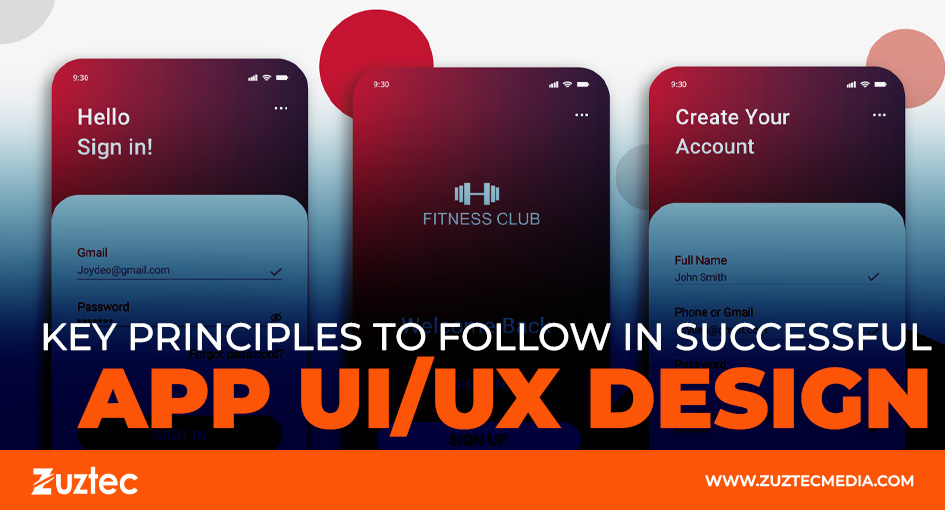
Key Principles To Follow In Successful App UI/UX Design
The way a mobile app feels and works for its users is crucial to its success in the digital world. While functionality is important, the design is what truly defines the user experience. An interface that is both aesthetically pleasing and easy to use increases user engagement, retention, and conversions. This is why app UI/UX design plays such a vital role in the development process.
UI (User Interface) refers to the visual layout of an app—the buttons, icons, spacing, typography, and color schemes. UX (User Experience), on the other hand, is about the overall journey—how smooth, logical, and enjoyable it is to use the app from start to finish. A strong design blends both, creating a cohesive experience that feels both attractive and efficient.
Well-designed apps not only attract users but also reduce bounce rates and increase customer loyalty. Whether it’s an e-commerce app, a health tracker, or a social media platform, users expect easy navigation, clear feedback, and responsive interfaces.
Research, user personas, and prototyping help designers build experiences that feel personalized and intuitive. By minimizing friction and maximizing clarity, thoughtful design ensures that users spend more time engaging with the app and less time figuring out how to use it.
App UI/UX Design And Its Impact On User Engagement
Application UI/UX design is the backbone of user engagement. It defines how users navigate, understand, and respond to your mobile application. Poor design, however, leads to frustration, high uninstall rates, and negative reviews.
A clear, visually balanced interface gives users confidence. Good navigation, logical structure, and readable fonts allow users to perform tasks without confusion. Consistency is also important—icons, buttons, and screens should behave similarly throughout the app to reduce the learning curve. Microinteractions, like subtle animations or button feedback, improve satisfaction by confirming that a task is completed.
UX designers also consider loading times, screen transitions, and how quickly users can achieve their goals. The aim is to make every tap meaningful and efficient. A short signup process, easy checkout, or simplified form submission can increase conversion and reduce drop-off.
Ultimately, UI/UX design isn’t only about aesthetics. It’s about making users feel comfortable, understood, and supported. Every color, line, and animation plays a role in building trust and encouraging repeat usage.
Best Practices For Creating Exceptional Mobile Interfaces
Creating a great mobile UI/UX starts with user research. Knowing your audience’s behavior, preferences, and pain points lets you build features they’ll use. These tools also allow for testing early in the process, so improvements can be made without major rework.
Design simplicity is key. Overloading screens with text, buttons, or graphics causes confusion. Instead, focus on minimalism—only include what is necessary and helpful. Use clear icons, brief labels, and consistent spacing to guide the user naturally.
Accessibility should also be a priority. Design should accommodate all users, including those with visual or motor impairments. Using proper contrast ratios, readable font sizes, and voice control features enhances usability and broadens your app’s reach.
Regular user feedback and updates based on usage analytics ensure that your design remains effective over time. An app that evolves with user needs stays relevant and competitive.
In today’s saturated mobile app market, first impressions count. With thousands of apps competing for attention, strong app UI/UX design is a decisive factor in winning users. A well-crafted design can turn casual visitors into loyal customers, while a poor design can result in uninstalls after just one use.
Popular apps like Instagram, Uber, and Spotify succeed largely because of their design choices. They simplify complex actions and offer seamless user journeys. Their success stories show that UI/UX is not just support for functionality—it is a strategic advantage.
Investing in professional design is often more cost-effective than extensive marketing. A good app design brings organic growth through word-of-mouth and positive reviews. It also increases the return on investment by maximizing user retention and engagement.
Final Thoughts On The Value Of UI/UX Design
UI/UX design is a critical component of any successful mobile application. It bridges the gap between technology and human experience, ensuring that users not only understand your app but also enjoy using it. An intuitive interface combined with a seamless experience turns casual downloads into long-term users.
Focusing on thoughtful design enhances every aspect of your app, from initial impressions to daily usage. It reduces support costs, improves reviews, and drives more conversions. More importantly, it helps your app stand out in a competitive market where users expect speed, clarity, and efficiency.
Whether you’re building a new product or updating an existing one, prioritizing app UI/UX design is a smart, strategic move. It supports your brand, delights your users, and lays the foundation for sustainable growth in the digital space.

